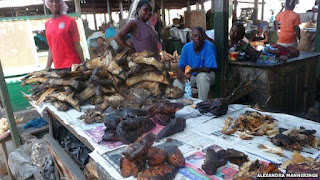 |
| None of these plants will cure itching. |
I’ve written a lot over the years about bad science. A particular gripe of mine is when bogus scientific results, sometimes fraudulent, sometimes just sloppy, manage to sneak into the peer-reviewed scientific literature. This happens all too often, especially as the number of papers published each year has grown. These bad papers are then used by fraudsters and charlatans (and sometimes by innocent people who just don’t have the expertise to understand) to “prove” an unscientific claim.
Fortunately, a growing number of journals–the better ones, in general–are showing more concern than in the past, and taking actions (sometimes) to retract papers, even over the objections of the authors.
Before I get to the good news, a reminder about the most notorious scientific paper in recent memory: Andrew Wakefield’s fraudulent study in The Lancet, published in 1998, which claimed to find a link between vaccines and autism. The Lancet, to its everlasting shame, failed to retract the article until 2010, despite an avalanche of evidence that began appearing in 2002. Ten of the original 13 authors even published their own “Retraction of an Interpretation” in 2004, but The Lancet still refused to retract unless all the authors agreed. Wakefield, who was already leading the anti-vaccine movement and is now adored by anti-vaxxers, refused.
That article has probably contributed indirectly to the deaths of thousands of people from vaccine-preventable infectious diseases. And given what we knew about it by 2002, The Lancet had no excuse for delaying retraction until 12 years after publication.
But I digress. Today I want to highlight an article whose retraction I called for a few years ago, one that the journal, Scientific Reports (published by Nature Publishing Group) did indeed retract, about 9 months later.
The paper I called out was a study that claimed that an extract of poison oak can be used to treat pain. If that sounds kind of ridiculous, that’s because it is. The actual paper sounded very science-y, as I pointed out in my original column. It was titled “Ultra-diluted Toxicodendron pubescens attenuates pro-inflammatory cytokines and ROS-mediated neuropathic pain in rats.”
Toxicodendron pubescens, in case you’re wondering, is poison oak. It’s not a tree and it has nothing to do with oaks–it’s a cousin of poison ivy, and both plants contain oils that can cause extreme itching and painful rashes on contact.
How on earth could poison oak be used to treat pain? Well, it can’t. The paper was actually about a homeopathic treatment. One of the core tenets of homeopathy is that “like cures like,” as long as you dilute it sufficiently. So the poison oak paper started with the premise that since poison oak causes pain and itching, you can also use it, after you dilute it, to treat pain and itching!
Homeopathy, as I’ve written before, is a highly implausible and easily disprovable set of beliefs about medicine. I use the word “belief” intentionally here, because homeopathy really has no claim to be a type of medicine, or even a hypothesis. It’s just a 200-year-old collection of beliefs that turned out, long ago, to be wrong.
If this sounds absurd, well, selling these products is a highly profitable business. For example, check out Boericke & Tafel’s Oral Ivy Liquid ($15 for a 1-ounce bottle on Amazon.com), a homeopathic product that is made from poison ivy, poison oak, and poison sumac. It claims to be “for the prevention and temporary relief of contact dermatitis associated with poison ivy, poison oak or poison sumac.” What’s in it? Poison oak, at very low levels. (Actually this product isn’t really diluted to homeopathic levels: the packaging says it contains 0.02g of poison oak in each drop. So it might actually cause an allergic reaction–I’d stay far away from this stuff.)
Back to the study: in the paper, the authors diluted a preparation of poison oak down to levels as low as 10-30, a common practice in homeopathy. The problem is, at that level of dilution, not even a single molecule of the original substance would remain. There’s simply no possibility that such a dilution could have any therapeutic benefit, but somehow they found an effect. Hmm.
A number of scientists wrote to the journal complaining that this result was extremely implausible, and that the experiments didn’t support the conclusions. To their credit, the journal editors took the complaints seriously and investigated. The retraction notice (read it here) pointed out another major problem as well: some of the figures were duplicates! Each figure is supposed to represent a different experiment, so duplication is a big problem, added to the fundamental implausibility of the study.
As is often the case when fraud is detected, the authors did not agree with the retraction.
When I wrote my column complaining about this study, I said the “the right thing to do would be to retract this paper, because its results are simply not valid. We'll see if that happens.” Well, about 9 months later, that’s exactly what happened.
A few years ago, I was in direct contact with the Editors-in-Chief at both Scientific Reports and PLoS ONE (about different papers than the one I’m discussing above), and they expressed genuine concern about fraudulent research, as well as a determination to do better at rooting it out. When journals do the right thing, we should applaud them. So here’s to Scientific Reports, who got it right this time.
